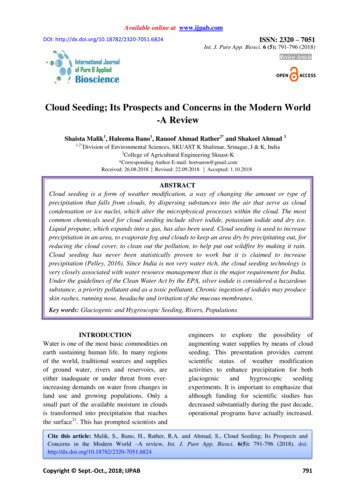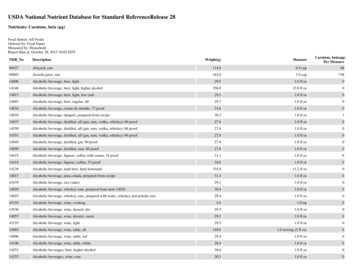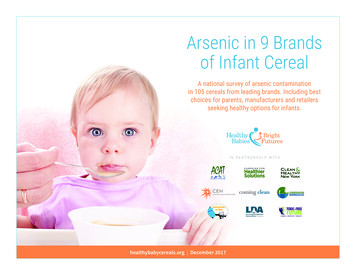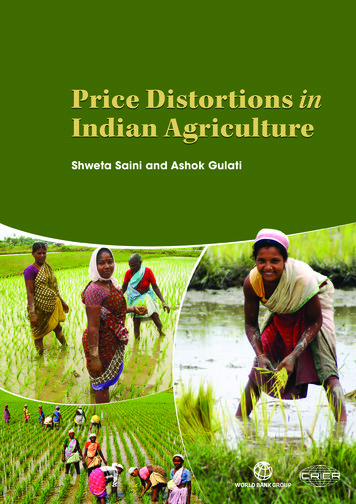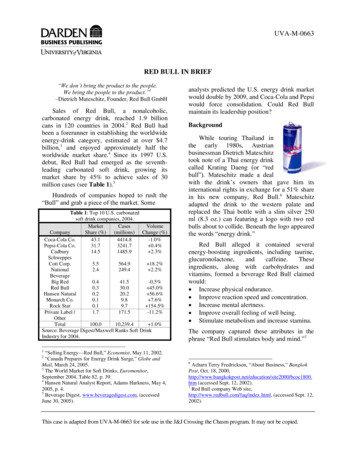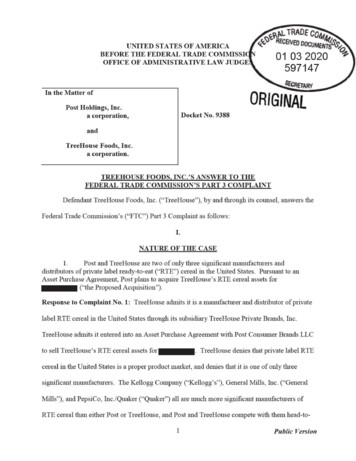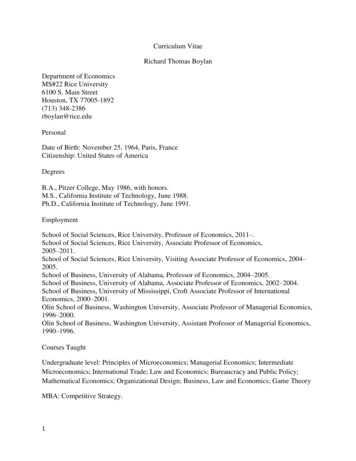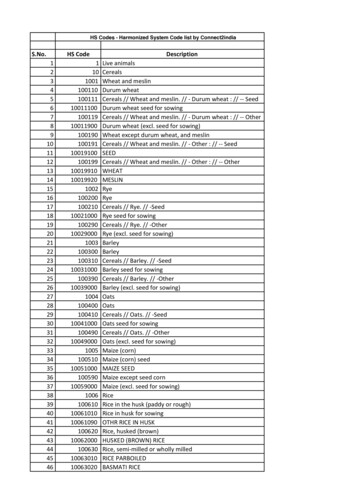
Transcription
C H A P T E RS I XDirect Seeding of Rice:Recent Developments and FutureResearch NeedsVirender Kumar and Jagdish K. LadhaContents1. Introduction2. Drivers of the Shift from Puddled Transplanting toDirect Seeding of Rice2.1. Major drivers2.2. Other drivers3. Types of Direct-Seeded Rice3.1. Dry direct seeding3.2. Wet direct seeding3.3. Water seeding4. Current Cultivation Practices for Direct-Seeded Rice: Case Studiesof the United States, Sri Lanka, and Malaysia4.1. The United States4.2. Sri Lanka4.3. Malaysia5. The Performance of Direct-Seeded Rice Compared withTransplanted Rice5.1. Rice grain yield5.2. Irrigation water application and irrigation water productivity5.3. Labor use5.4. Economics5.5. Greenhouse gas (GHG) emissions6. Potential Benefits and Risks Associated with Direct-Seeded Rice7. Weeds in Direct-Seeded Rice: A Major Constraint7.1. Evolution of weedy rice7.2. Changes in composition and diversity of weed flora and ashift toward more difficult-to-control weeds7.3. Evolution of herbicide 35339342342347353354355359360International Rice Research Institute, India office, Pusa, New Delhi, IndiaAdvances in Agronomy, Volume 111ISSN 0065-2113, DOI: 10.1016/B978-0-12-387689-8.00001-1#2011 Elsevier Inc.All rights reserved.297
298Virender Kumar and Jagdish K. Ladha8. Breeding Cultivars for Direct-Seeded Rice8.1. Anaerobic germination and tolerance of early submergence8.2. Early vigor8.3. Crop competitiveness against weeds8.4. High crop growth rate during the reproductive phase8.5. Modified panicle architecture8.6. Modified root system8.7. Lodging resistance8.8. Shorter-duration rice cultivars9. A Dry Direct Drill-Seeded Rice Technology Package for the MajorRice-Based Systems in South Asia9.1. Precise land leveling9.2. Crop establishment9.3. Precise water management9.4. Effective and efficient weed management9.5. Fertilizer management10. Conclusions and Future Outlook10.1. What are the different types of direct seeding andtheir niches?10.2. What are the major drivers of the shift from puddledtransplanting to direct seeding?10.3. What lessons have we learned from those countries wheredirect seeding is widely adopted?10.4. Can direct seeding be as productive as conventional puddledtransplanted rice?10.5. Does direct seeding save on the use of labor or water?10.6. Is direct-seeded rice economically attractive to farmers?10.7. How does direct-seeded rice influence greenhouse gasemissions?10.8. What plant traits are the most important for optimizingdirect-seeding systems?10.9. What have we achieved and what is still needed for attainingmaximum potential of direct-seeded 90391391391AbstractRice (Oryza sativa L.), a staple food for more than half of the world population, iscommonly grown by transplanting seedlings into puddled soil (wet tillage) inAsia. This production system is labor-, water-, and energy-intensive and isbecoming less profitable as these resources are becoming increasingly scarce.It also deteriorates the physical properties of soil, adversely affects the performance of succeeding upland crops, and contributes to methane emissions. Thesefactors demand a major shift from puddled transplanting to direct seeding of rice(DSR) in irrigated rice ecosystems. Direct seeding (especially wet seeding) is
Recent Developments in Direct-Seeding of Rice299widely adopted in some and is spreading to other Asian countries. However,combining dry seeding (Dry-DSR) with zero/reduced tillage (e.g., conservationagriculture (CA)) is gaining momentum as a pathway to address rising water andlabor scarcity, and to enhance system sustainability. Published studies showvarious benefits from direct seeding compared with puddled transplanting,which typically include (1) similar yields; (2) savings in irrigation water, labor,and production costs; (3) higher net economic returns; and (4) a reduction inmethane emissions. Despite these benefits, the yields have been variable insome regions, especially with dry seeding combined with reduced/zero tillagedue to (1) uneven and poor crop stand, (2) poor weed control, (3) higher spikeletsterility, (4) crop lodging, and (5) poor knowledge of water and nutrient management. In addition, rice varieties currently used for DSR are primarily selected andbred for puddled transplanted rice. Risks associated with a shift from puddledtransplanting to DSR include (1) a shift toward hard-to-control weed flora, (2)development of herbicide resistance in weeds, (3) evolution of weedy rice, (4)increases in soil-borne pathogens such as nematodes, (5) higher emissions ofnitrous oxide—a potent greenhouse gas , and (6) nutrient disorders, especially Nand micronutrients. The objectives of this chapter are to review (1) drivers of theshift from puddled transplanting to DSR; (2) overall crop performance, includingresource-use efficiencies of DSR; and (3) lessons from countries where DSR hasalready been widely adopted. Based on the existing evidence, we present anintegrated package of technologies for Dry-DSR, including the identification ofrice traits associated with the attainment of optimum grain yield with Dry-DSR.1. IntroductionRice is the world’s most important crop and is a staple food for morethan half of the world’s population. Worldwide, rice is grown on 161million hectares, with an annual production of about 678.7 million tonsof paddy (FAO, 2009). About 90% of the world’s rice is grown andproduced (143 million ha of area with a production of 612 million tons ofpaddy) in Asia (FAO, 2009). Rice provides 30–75% of the total calories tomore than 3 billion Asians (Khush, 2004; von Braun and Bos, 2004). Tomeet the global rice demand, it is estimated that about 114 million tons ofadditional milled rice need to be produced by 2035, which is equivalent toan overall increase of 26% in the next 25 years. The possibility of expandingthe area under rice in the near future is limited. Therefore, this extra riceproduction needed has to come from a productivity gain. The majorchallenge is to achieve this gain with less water, labor, and chemicals,thereby ensuring long-term sustainability.The Green Revolution technologies (the combination of higher-yielding cultivars, use of agrochemicals, including fertilizer, and irrigation) led toa rapid rise in rice yield, production, and area, which resulted in lower rice
Virender Kumar and Jagdish K. 52000.00Real price of milled rice (2008 US /ton)Average annual growth rate of riceyield and population (%)30070 72 74 76 78 80 82 84 86 88 90 92 94 96 98 00 02 04 06 0819 19 19 19 19 19 19 19 19 19 19 19 19 19 19 20 20 20 20 20Real rice price (2008)Rice yieldPopulationFigure 1 Trends of average annual growth rate of rice yield and population in Asia andworld market rice price (1970–2008). (Rice price: 2008 is as of May 2008 price. Relateto Thai rice 5%-broken deflated by G-5 MUV Index deflator (adjusted based on April17, 2008, data update). Source: www.worldbank.org.prices, thereby benefiting poor consumers in rural and urban areas in Asia(Fig. 1). Although the overall increase in rice production has kept pace withpopulation growth in Asia, growth in rice productivity has been decliningsince 1985 and, in more recent years, has fallen below the populationgrowth rate (Fig. 1). If continued, this sluggish growth in rice productivitywill cause significant imbalances between long-term supply and demand.In recent years, globally, consumption of rice surpassed production, whichhas led to the depletion of stocks. Current stocks are at their lowest since1988 (IRRI, 2008). Because of all these factors, the long-term decline inrice price ended in 2001, with a sharp increase in 2008 to a level that had notbeen seen for decades (IRRI, 2008; Fig. 1).The productivity and sustainability of rice-based systems are threatenedbecause of (1) the inefficient use of inputs (fertilizer, water, labor); (2)increasing scarcity of resources, especially water and labor; (3) changingclimate; (4) the emerging energy crisis and rising fuel prices; (5) the risingcost of cultivation; and (6) emerging socioeconomic changes such as urbanization, migration of labor, preference of nonagricultural work, concernsabout farm-related pollution (Ladha et al., 2009). Agronomic managementand technological innovations are needed to address these issues in Asia.In Asia, rice is commonly grown by transplanting seedlings into puddledsoil (land preparation with wet tillage). Puddling benefits rice by reducingwater percolation losses, controlling weeds, facilitating easy seedling
Recent Developments in Direct-Seeding of Rice301establishment, and creating anaerobic conditions to enhance nutrient availability (Sanchez, 1973). But, repeated puddling adversely affects soil physicalproperties by destroying soil aggregates, reducing permeability in subsurfacelayers, and forming hard-pans at shallow depths (Aggarwal et al., 1995; Sharmaand De Datta, 1985; Sharma et al., 2003), all of which can negatively effect thefollowing non-rice upland crop in rotation (Hobbs and Gupta, 2000; Tripathiet al., 2005a). Moreover, puddling and transplanting require large amount ofwater and labor, both of which are becoming increasingly scarce and expensive, making rice production less profitable. Also, the drudgery involved intransplanting—a job largely done by women—is of serious concern. All thesefactors demand a major shift from puddled-transplanted rice production (CTTPR) to direct seeding of rice (DSR) in irrigated areas. According to Pandeyand Velasco (2005), low wages and adequate availability of water favor transplanting, whereas high wages and low water availability favor DSR. Depending on water and labor scarcity, farmers are changing either their riceestablishment methods only (from transplanting to direct seeding in puddledsoil [Wet-DSR]) or both tillage and rice establishment methods (puddledtransplanting to dry direct seeding in unpuddled soil [Dry-DSR]).Direct seeding can be categorized as (1) Wet-DSR, in which sproutedrice seeds are broadcast or sown in lines on wet/puddled soil, and (2) DryDSR, in which dry rice seeds are drilled or broadcast on unpuddled soileither after dry tillage or zero tillage or on a raised bed. Another category ofDSR is water seeding, in which sprouted rice seeds are broadcast in standingwater. Wet-DSR is primarily done to manage the labor shortage, and iscurrently practiced in Malaysia, Thailand, Vietnam, the Philippines, andSri Lanka (Bhuiyan et al., 1995; Pandey and Velasco, 2002; Weerakoonet al., 2011). But, with the increasing shortages of water, the incentive todevelop and adopt Dry-DSR has increased. Dry-DSR production is negligible in irrigated areas but is practiced traditionally in most Asian countriesin rainfed upland ecosystems. Water seeding is widely practiced in theUnited States, primarily to manage weeds such as weedy rice, which arenormally difficult to control (Hill et al., 1991).Both Dry- and Wet-DSR have the potential to reduce water and laboruse compared with CT-TPR. Tabbal et al. (2002) in their on-farm studiesin the Philippines observed on average 67–104 mm (11–18%) of savings inirrigation water in Wet-DSR compared with CT-TPR when irrigationapplication criteria was same for both establishment methods. Cabangonet al. (2002) in the Muda region of Malaysia found that irrigation waterapplication in Dry-DSR was about 200 mm (40%) less than that in CTTPR. Similarly, 10–50% savings in water have been claimed with DryDSR compared with CT-TPR from India when irrigation applicationcriteria after crop establishment (CE) were either the appearance of hairlinecracks or tensiometer-based ( 20 kPa at 20-cm depth) (Bhushan et al.,2007; Jat et al., 2009; Sudhir-Yadav et al., 2011a,b). Similar to saving in
302Virender Kumar and Jagdish K. Ladhawater, DSR can reduce total labor requirements from 11% to 66% dependingon season, location, and type of DSR compared with CT-TPR (Isvilanonda,2002; Kumar et al., 2009; Rashid et al., 2009; Santhi et al., 1998; Tisch andParis 1994; Wong and Morooka, 1996). Labor requirements for CE decreaseby more than 75% with direct seeding compared with transplanting (Dawe,2005; Isvilanonda, 2002; Pandey and Velasco, 2002).The way DSR is currently practiced differs considerably in differentcountries. Land preparation (tillage), establishment methods, seed rate,water management, weed management, and nutrient management varyfrom location to location. For example, seeding rates range from 20 to60 kg ha 1 in South Asia to up to 200 kg ha 1 in some Southeast Asiancountries (de Dios et al., 2005; Gupta et al., 2006; Guyer and Quadranti,1985). Cleaning and plastering of bunds are an important component offield preparation for both weed and water management in Wet-DSR in SriLanka (Weerakoon et al., 2011). A mix of traditional and modern practicesbased on farmers’ long experiences and research innovations are beingfollowed. Although a wealth of available information can lead us to developDSR technologies that are suitable for wider agroecological conditions,more innovations are needed in the context of emerging challenges thatfuture rice cultivation is likely to face.During the past decade or so, there have been numerous efforts to findalternatives to the conventional practice of CT-TPR (Ladha et al., 2009).Many of these studies have also considered ways to avoid or minimizeextensive land preparation/tillage, which most farmers currently practice.In addition, there is a rich body of literature on case studies of DSR fromcountries where it is practiced widely. We believe that a systematic inventory and critical review of past and recent work would provide insight toenable us to develop efficient and viable rice production systems needed inthe twenty first century. Therefore, the purpose of this review is to takestock of DSR. Specifically, we (1) analyze the reasons for a shift frompuddled transplanting to different types of DSR, (2) summarize the currentmanagement practices of DSR in different countries, (3) compare theperformance of different types of DSR with CT-TPR, (4) summarize thetechnological package of Dry-DSR including under zero tillage for majorrice-based systems in South Asia, and (5) suggest future research needs formaking direct-seeding systems more productive and sustainable. We aim toprimarily target irrigated or favorable rainfed rice lowlands, which wouldcontinue to supply the growing rice demand (presently supplying 75% ofworld rice from about 50% of total rice area), and where the impact of shiftsto DSR in saving of resources (i.e., labor and water) would be the greatest.Various modifications of tillage/land preparation and CE are used to suitsite-specific requirements. For the purpose of simplicity, these modifications are commonly referred to as alternative tillage/CE in this chapter.However, specific modifications are described when necessary.
Recent Developments in Direct-Seeding of Rice3032. Drivers of the Shift from PuddledTransplanting to Direct Seeding of Rice2.1. Major drivers2.1.1. Water scarcity2.1.1.1. Current rice culture is a major freshwater user and is highlyinefficient in its use Rice is a major user of freshwater because of its largearea and consumption, which are, two to three times more than other cereals(Barker et al., 1998; Carriger and Vallée, 2007; Tuong et al., 2005). Riceconsumes about 50% of total irrigation water used in Asia (Barker et al., 1998)and accounts for about 24–30% of the withdrawal of world total freshwaterand 34–43% of the world’s irrigation water (Bouman et al., 2007).Conventional rice production systems (puddled transplanting) requirelarge quantities of water. On average, 2500 l of water are applied, rangingfrom 800 to more than 5000 l, to produce 1 kg of rough rice (Bouman,2009). The seasonal water input to rice fields is the combination of waterused in land preparation and to compensate for evaporation, transpiration,seepage, and percolation losses during crop growth. Most of the waterapplied during crop growth is not used directly for transpiration, and istherefore considered lost from fields. Tuong and Bouman (2003) estimatedseasonal water input for typical puddled transplanted rice to vary from 660to 5280 mm depending on growing season, climatic conditions, soil type,and hydrological conditions, with 1000–2000 mm as a typical value in mostcases. This consists of (1) 160–1580 mm for land preparation (puddling),with a typical value of 150–250 mm (Tuong, 1999); (2) 400–700 mm forevapotranspiration (ET) (600–700 mm in the dry season and 400–500 mmin the wet season); and (3) 100–3000 mm of unavoidable losses due topercolation and seepage (range of 100–500 mm for heavy clays and 1500–3000 mm for loamy/sandy soils). Tripathi (1990) studied seasonal water inputto rice in India, which ranged from 1566 mm in a clay loam soil to 2262 mmin a sandy loam soil, with variations due primarily to deep percolation losses.Gupta et al. (2002) estimated water use for rice in the Indo-Gangetic Plains,which varied from 1144 mm in Bihar to 1560 mm in Haryana. In thePhilippines, water use has been reported at 1300–1500 mm for the dry seasonand 1400–1900 mm for the wet season (Bouman et al., 2005).The water productivity of rice in terms of ET is not different from otherC3 cereals such as wheat (Table 1). The higher water application in rice ismostly due to water requirements for puddling and losses associated withcontinuous flooding such as seepage and deep percolation losses to groundwater (Hafeez et al., 2007). Seepage and percolation losses vary from 25% to85% of total water input depending on soil type and water table (25–50% inheavy soils with shallow water tables and 50–85% in coarse-textured soil
304Table 1cerealsVirender Kumar and Jagdish K. LadhaAmount of water evapotranspired (liters) to produce one kilogram of majorCropPhotosynthesis 71667909AverageMedian917917556980980625(L)Source: Zwart and Bastiaanssen (2004).with deep water-table depth 1.5 m) (Cabangon et al., 2004; Choudhuryet al., 2007; Dong et al., 2004; Sharma et al., 2002; Singh et al., 2002a).Although the losses through seepage and percolation are often real for anindividual farmer at the field level, they are often not as great at the basinscale since some water is recaptured and used downstream.2.1.1.2. Water scarcity is increasing and availability of water foragriculture is decreasing Globally, water is becoming an increasinglyscarce resource. In the major rice-growing Asian countries, per capitawater availability decreased by 34–76% between 1950 and 2005 and is likelyto decline by 18–88% by 2050 (Table 2). There are two key types of waterscarcity: physical and economic. Physical scarcity occurs when the demandof the population exceeds the available water resources of a region.Economic water scarcity occurs when water is adequate, but is unavailabledue to a lack of significant investment in water infrastructure (IWMI, 2000;Rijsberman, 2006).Irrigated crop production increasingly faces competition for water fromthe other nonagriculture sectors. At present, irrigated agriculture accountsfor 70% and 90% of total freshwater withdrawal globally and in Asia,respectively (Molden et al., 2007; Tabbal et al., 2002). The share of waterfor agriculture is declining fast, for which the reasons are often locationspecific, including (1) rising population, (2) falling groundwater table, (3)deteriorating water quality due to chemical pollution, salinization, etc., (4)inefficient irrigation systems, (5) changing food diet, and (6) competitionwith nonagricultural sectors (domestic, industrial, and environmental).In Asia, the share of water in agriculture declined from 98% in 1900 to80% in 2000 and is likely to further decline to 72% by 2020 (Fig. 2). InChina, the water share in agriculture dropped from 88% in 1980 to 65% in2005 and is likely to go down to 50% by 2050 (Fig. 2). Similarly, in otherrice-growing Asian countries also, the share of water in agriculture isdeclining (Fig. 3). These data envisage significant transfers of water fromirrigation to other sectors by 2050, thus warranting the development anddeployment of highly water use efficient crop production technologies.
Table 2 Per capita water availability in major rice-growing countries of Asia apanMalaysiaNepalPakistanPhilippinesSouth KoreaSri 24230228714780aProjections based on intermediate population growth rate.Source: Modified from Gardner-Outlaw and Engelman 973467139622101500199024403367
306Virender Kumar and Jagdish K. Ladha10090Share of total waterin agriculture 202040ChinaFigure 2 Agriculture’s share of water use in Asia and China from 1900 to 2050.Source: State Hydrological Institute (2009) and Jiang (2009).Agriculture's share of totalwater withdrawal (%)120100806040200IndiaMalaysiaSri Lanka1990VietnamIndonesia2000Figure 3 Agriculture’s share of total water withdrawal in different rice-growing Asiancountries in 1990 and 2000. Source: FAO AQUASTAT (2009).Another evidence of growing water scarcity is the depleting groundwater resources, especially in South Asia and North China (Postel, 1997; Shahet al., 2007), threatening the most intensive irrigated rice–wheat growingareas. Groundwater tables have fallen in the major rice-growing countries.In the Indian states of Punjab, Haryana, Gujarat, Tamil Nadu, Rajasthan,
307Recent Developments in Direct-Seeding of RiceMaharashtra, and Karnataka, it is falling at 0.5–2 m per year (Singh andSingh, 2002; Tuong and Bouman, 2003). In a recent study, jointly carriedout by NASA and the German Aerospace Center (DLR), satellite datashowed a groundwater table decline rate of 0.33 m per year in northwesternIndia (Rodell et al., 2009; UC Irvine, 2009). The study estimated that over aperiod of 6 years (from August 2002 to October 2008), there was a net lossof 109 km3 of groundwater in northern India, double the capacity of India’slargest surface reservoir (Rodell et al., 2009). In Bangladesh, because ofheavy groundwater use, shallow wells are going dry by the end of the dryseason (Ahmed et al., 2004).Similarly, in the North China Plains, many studies have reportedincreasing groundwater depletion (Bouman et al., 2007; Liu and Yu,2001; Xia and Chen, 2001). Water tables have dropped on average by1–3 m per year in the region (Bouman et al., 2007). In the western part ofthe 3-H basin, the groundwater table dropped from 3–4 m in the 1950s to20 m in the 1980s and to 30 m in the 1990s (Liu and Xia, 2004). In China,groundwater overexploitation area has increased from 87,000 to180,000 km2 since the early 1980s (MWR, 2007).The decline in the water table is mainly because of the heavy use ofgroundwater for irrigation as evidenced from intensive groundwater development (tubewells) during the past decades. Groundwater withdrawalstructures and groundwater use in South Asian countries and China haveincreased rapidly (Table 3). For example, in India, the number of groundwater structures (dug wells and tubewells) increased from 3.9 million in1950–1951 to more than 20 million in 2000 (Fig. 4) and they currentlyextract 185–210 km3 year 1 of groundwater (Table 3).Increasing water scarcity has threatened the productivity and sustainability of the irrigated rice system in Asia (Tuong et al., 2004). It is expectedthat the irrigated rice regions of South and Southeast Asia will experiencesome degree of water scarcity by 2025. About 13 million ha of Asia’sirrigated wet-season rice and 2 million ha of irrigated dry-season rice mayTable 3 Number of groundwater structures (millions) and annualgroundwater use (km3 year 1) in South Asian countries and ChinaCountryGroundwaterstructures (million)Groundwateruse (km3 year 1)BangladeshChinaIndiaPakistanNepal Tarai0.803.5020.000.800.063175185–21045–55 1Source: Deb Roy and Shah (2002), Shah (2005), and Qureshi et al. (2008).
308Virender Kumar and Jagdish K. LadhaGroundwater structures (millions)25201510501950– 1960– 1968– 1973– 1977– 1979– 1984– 1989– 1993– 1996– 2000–5161697478808590949701Figure 4 Groundwater withdrawal structures (millions) in India from 1950 to 2001.Sources: Adapted from Singh and Singh (2002) and Shah (2005).experience physical water scarcity, and about 22 million ha of irrigated dryseason rice may suffer economic water scarcity by 2025 (Tuong andBouman, 2003).2.1.1.3. Water scarcity as a driver for direct seeding A grim water scenario in agriculture together with the highly inefficient rice productiontechnologies currently adopted by a majority of farmers globally warrantsthe exploration of alternative rice production methods, which inherentlyrequire less water and are more efficient in water use. DSR provides someopportunities for saving water. Both Dry- and Wet-DSR are more waterefficient and have an advantage over CT-TPR (Bhuiyan et al., 1995; Dawe,2005; Humphreys et al., 2005; Tabbal et al., 2002). However, with increasing shortage of water, Dry-DSR with zero or minimal tillage in whichpotential savings of both labor and water can be much higher appears tohave the greatest potential, especially for irrigated areas of Asia.2.1.2. The labor shortage and increasing labor wagesCT-TPR is highly labor intensive. Both land preparation (puddling) and CEmethods (transplanting) of CT-TPR require a large amount of labor. Rapideconomic growth in Asia has increased the demand for labor in nonagricultural sectors, resulting in reduced labor availability for agriculture (Dawe,2005; Fig. 5). For example, labor forces in agriculture are declining at 0.1–0.4%, with an average of 0.2% per year in Asia. In Bangladesh, Malaysia, andThailand, the decline rate is much higher (0.25–0.40%), followed by India,the Philippines, and Cambodia (0.18%). In Bangladesh and Malaysia, theproportion of the labor force involved in agriculture dropped from 45% and
309Recent Developments in Direct-Seeding of RiceAgricultural labor force(% of total y –0.19 x 403Bangladeshy –0.41 x 851Chinay –0.10 x 247Indiay –0.18 x 395Indonesiay –0.11 x 234Malaysiay –0.33 x 664Philippinesy –0.18 376Thailandy –0.25 x 542Vietnamy –0.10 x 243Cambodiay –0.18 x 364Linear regressionFigure 5 Agricultural labor force (% of total population) in selected Asian countriesfrom 1960 to 2010. Source: IRRI World Rice Statistics database, available ion¼com content&task¼view&id¼250.22% in 1961 to 25% and 6% in 2008, respectively. Similarly, in Thailand andVietnam, the agricultural labor force dropped from 40% in the 1960s to 30–35% now. In addition, in the present changing socioeconomic environmentin Asia, most people prefer nonagricultural work. Moreover, governmentpolicies such as The Mahatma Gandhi National Rural Employment Guarantee Act, introduced by the Indian government in 2005 (GOI, 2011),promising 100 days of paid work in people’s home village, is creating alabor scarcity in the cereal bowl of northwest India, which is dependent onmillions of migrant laborers from eastern Uttar Pradesh and Bihar for ricetransplanting. Because of increasing labor scarcity, labor wages have gone up(e.g., shown in Fig. 6 for four Asian countries), which is making the CT-TPRproduction system uneconomical in many Asian countries. Because of highlabor demand at the time of transplanting, increasing labor scarcity and risingwage rates are forcing farmers to opt for a shift in method of rice establishmentfrom transplanting, which requires 25–50 person-days ha 1, to direct seeding,which in comparison needs about 5 person-days ha 1 (Balasubramanian andHill, 2002; Dawe, 2005).2.2. Other drivers2.2.1. Crop intensification and recent developments inDSR production techniquesAlthough labor and water are the major drivers for the shift from CT-TPRto DSR, economic incentives brought out by DSR through the integrationof an additional crop (crop intensification) are another reason for the rapid
310Virender Kumar and Jagdish K. Ladha4.0Wages (US ri Lanka1.00.50.0196019701980199020002010Figure 6 Trend of farm labor wages (US day 1) in selected Asian countries from1960 to 2007. Source: IRRI World Rice Statistics database, available online om content&task¼view&id¼250.spread/adoption of DSR in some regions. For example, in the MekongDelta in Vietnam and Iloilo in the Philippines, DSR facilitated doublecropping instead of a single crop of transplanted rice (Pandey and Velasco,2002). Early establishment and short-duration varieties (95–105 days) permitted early harvesting of Dry-DSR in August, therefore, leaving enoughtime and rainfall to grow another rainfed crop of rice in Long An Provincein the Mekong River Delta region of Vietnam. Some farmers can evengrow a third crop of rice with supplemental irrigation during December toFebruary (My et al., 1995). DSR has gradually and steadily increased,covering almost 100% of the area, allowing double to triple crops in theregion. Notably, the availability
8. Breeding Cultivars for Direct-Seeded Rice 360 8.1. Anaerobic germination and tolerance of early submergence 362 8.2. Early vigor 362 8.3. Crop competitiveness against weeds 362
